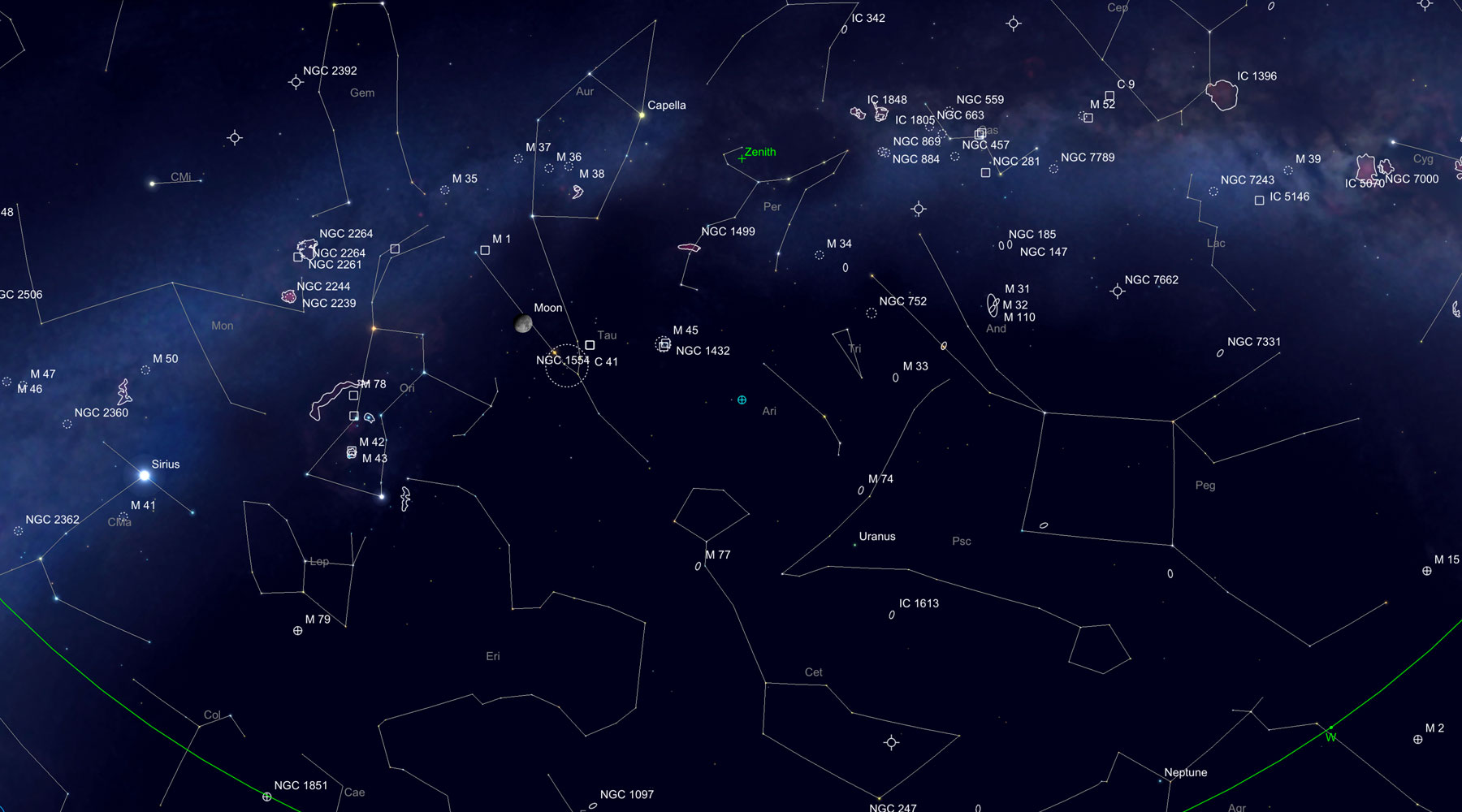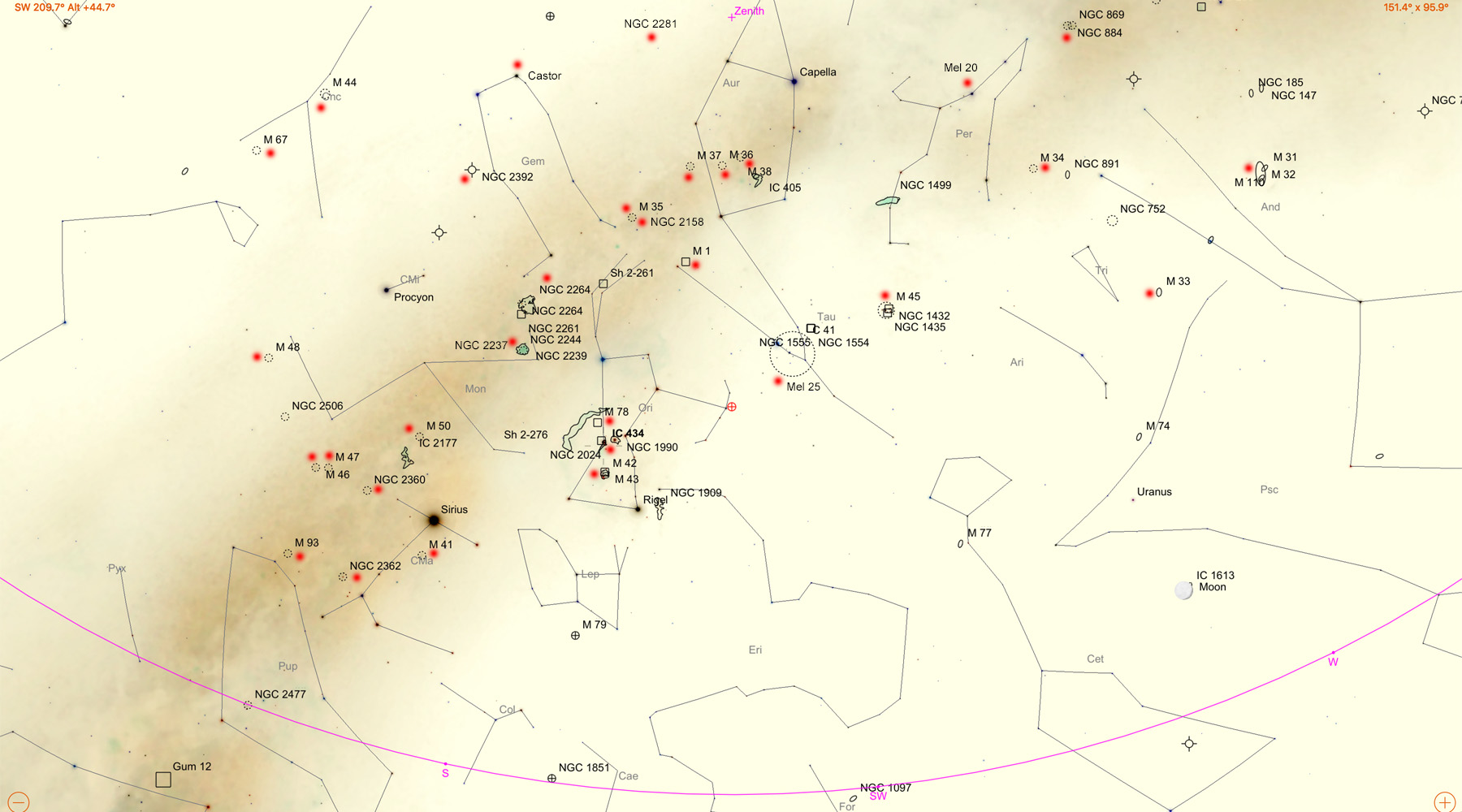Deep Sky Winter Observations Mid-January - March 2018
Conditions | Observation Overview | List of Observed Sky Objects | References
From mid-January 2018 until March 2018, I did simple "deep-sky winter observations", often with binoculars, which might be of interest to other beginners and are therefore described here.
Conditions
Sky Region and Objects
My observations ranged between the Orion in the East to Andromeda, Cassiopeia, and Hercules in the West. I mostly "hunted" for objects that can be observed with binoculars.
Overview Map
The following map (January 2018) shows approximately the sky area that I primarily browsed during my observations:
Click the map for a larger version - it opens in a new window (Image Courtesy of SkySafari Astronomy, www.simulationcurriculum.com)
And here an inverted map for February 2018 with marked possible targets:
Click the map for a larger version - it opens in a new window (Image Courtesy of SkySafari Astronomy, www.simulationcurriculum.com)
Observation Time
Observations started early, often briefly after sunset. In March, this was, of course, a little bit later than in January...
Observation Location
Most of the observations were conducted in Mühlhausen/Kraichgau (Germany):
- Coordinates: 49° 15′ N , 8° 43′ E
- Coordinates (dec.): 49,25° N, 8,72° E
A few observations were conducted in Kellinghusen and Erkerode (both located in Germany).
Devices Used
- Sky-Watcher Skymax-102 OTA
- Sky-Watcher Skymax-127 OTA
- Sky-Watcher Explorer 150PDS
- Sky-Watcher Star Discovery AZ GoTo Mount
- Celestron StarSense AutoAlign for Sky-Watcher
- TS 10 x 60 binoculars
- Leica Trinovid 10 x 25 binoculars
General Conditions
In general, the sky above Mühlhausen/Kraichgau is "light-polluted" and does not invite you to search for deep sky objects. This is certainly one of the reasons why I found some of the deep sky objects that I wanted to observe only sometimes or not at all.
The sky above Kellinghusen is considerably darker, and the one above Erkerode is in any case better than the one above Mühlhausen.
Observation Overview
| Date 2018 |
Observed Objects | Details, Remarks | Further Observations and Remarks | Devices Used | Eyepieces Used |
| Jan 14 | GE: M42/43 (Orion Nebula) OS: M 35, M 45 (Pleiades), Mel 25 (Hyades), Mel 20 (Mirfak Cluster), NGC 884/869 (Perseus Double Cluster) |
Skymax-127/102 used with different magnifications: M 42/43 was nice,
especially in the 127 for the pointed wings; both telescopes showed the
Trapezium well, no really big differences between the two telescopes.... TS-Binoculars: M 35 was beautiful as never before, M 42/3, M 45, Hyades, Alpha Persei Cluster, Perseus Double Cluster |
TS binoculars, Skymax-102/127 | not documented | |
| Feb 4 | GE: M 31 (Andromeda Galaxy) OS: M 35, M 45, Mel 25, Mel 20, NGC 884/869 |
Skymax-102 and 127 on M 31: no major differences detectable, focusing
worked better on the 127; M 31 was similarly bright but smaller in the
TS binoculars TS-Binoculars: M 31, Mirfak Cluster, Perseus Double Cluster, Pleiades, Hyades, M 35 (faint, more a guess...) Eye: Betelgeuze for the first time consciously seen "yellow-red"... |
TS binoculars, Skymax-102/127 | not documented | |
| Feb 5 | G: M 31 GE: M42/43 OS: M 35, M 45, Mel 25, Mel 20, NGC 884/869 |
Skymax-102 and 127 compared using M 42/43 and M 35: M 42/43: Different eyepieces tried, Trapezium tested, actually no differences on the trapezoid in contrast to what Mr. Kloß wrote.... Most likely differences in the nebula structure and contrast... M 35: appears with more contrast in the 127, otherwise hardly any differences... TS Binoculars: Viewed again all "standards", at the end also found M 31. M 35 better recognizable as a "nebula" than the day before. |
TS binoculars, Skymax-102/127 | used different eypieces | |
| Feb 12 | G: M 31 GE: M 42/3 OS: M 35, M 36, M 37, M 38, M 45, NGC 884/869 |
All objects seen well in the telescope. Afterwards, some were photographed with Atik Infinity: M 35, M 36, M 37, M 38, M 42/43 (see special page) |
Using the StarSense module was successful in my 2nd attempt (after problems on Feb, 8), the camera also worked well. | Explorer 150PDS GT with StarSense module (also with AI) | not documented |
| Feb 13 | G: M 31 GE: M 42/3 OS: M 35, M 36, M 37, M 38, M 45, Mel 25, Mel 20, NGC 884/869 |
All 10 objects seen well in binoculars | TS binoculars | ||
| Feb 21 | GE: M 42/43 OS: M 35, M 37 |
Everything seen well. Afterwards, some were photographed with Atik Infinity: M 35, M 42/43, Half Moon (see special page) |
Explorer 150PDS GT (also with AI) | not documented | |
| Feb 22 | GE: M 42/43 OS: M 45, Mel 25 |
Infinity 76: M 42/43, M 45, Mel 25 Skymax-102/127: M 42/43 |
Skymax-102/127 | not documented | |
| Mar 14 | GE: M 42/43, OS: M 41, M 93, M 50, M 45 |
Explorer 150PDS: M 42/43, M 41, M 93, M 50 Ditto with Atik Infinity: M 42/43, M 41, M 93, M 50, M 45 (see special page) Binoculars: M 42/43 |
TS and LT binoculars; Explorer 150PDS (also with AI) |
24 mm | |
| Mar 18 | GE: M 42/43 OS: M 35, M 36, M 37, M 38, M 45, Mel 25, Mel 20, NGC 884/869 |
Skymax-102 (24 mm): M 42/43 (super, extended), M 45 (sparkling) Binoculars: M 42/43, M 45, Mel 25, Mel 20, NGC 884/869, M 35, M 36-38 (the center cluster was the smallest and somewhat lower, the right one the largest, the left one in between); all OCs seen very well |
Kellinghusen | TS and LT binoculars; Skymax-102 |
24 mm |
| Mar 19 | GE: M 42/43 OS: M 41, M 35, M 36, M 37, M 38, M 45, Mel 25, Mel 20, NGC 884/869 |
Skymax-102 (24 mm): M 42/43 (super, extended), M 41 (nice, large) Binoculars: M 42/43, M 41, M 45, Mel 25; M 35, M 36-38 - everything as nice as the day before; M 41 added; Christmas Tree cluster NGC 2264 not found… |
Erkerode | TS and LT binoculars; Skymax-102 |
24 mm |
| Mar 20 | OS: M 44, M 67 | Cancer: M 44 (nice, many stars), M 67 (faint) | Erkerode | TS and LT binoculars | |
| Mar 24 | GE: M 42/43 OS: M 41, M 44, M 47, M 48, M 50, M 93 |
All in all, not very good conditions because of the Half Moon; M 41 worked best, M 47, 48, and 50 were OK; M 44 quite nice; M 93 partly not found | Not seen/found: M 67, M 46, M 93 (partly), NGC 2360, NGC 2362 | Explorer 150PDS GT with StarSense module | 24 mm |
Bold: First observation during this observation period; all observations
done in Mühlhausen/Kraichgau, except for where noted otherwise
G = galaxy, OC
= open star cluster, GC = globular star cluster, GE = galactic emission nebula
List of Observed Sky Objects
Object details can be obtained via the links to the relevant deep sky objects.
|
DSO Details
|
Name | Constellation | Type | Bino* | 150PDS GT/S | SM-102 | SM-127 | Remarks** |
| M 31 | Andromeda Galaxy | Andromeda | G | yes | yes | yes | yes | a glow in binoculars, not much better in the telescope... |
| NGC 884/869 | Perseus Double Cluster | Perseus | OC | yes | yes | seen well in binoculars, with "oval" of stars | ||
| Mel 20 | Alpha Persei Cluster (Mirfak) | Perseus | OC | yes | seen well in binoculars, very extended | |||
| Mel 25 | Hyades | Taurus | OC | yes | seen well in binoculars, very extended | |||
| M 45 | Pleiades | Taurus | OC | yes | yes | seen well in binoculars | ||
| M 42/43 | Orion Nebula | Orion | GE | yes | yes | yes+ | yes | M 42/43 seen well in binoculars; seen very nicely in the telescope when the sky was dark |
| M 35 | Gemini | G | yes | yes | M 35 seen well as a glow in binoculars under a dark sky; seen well in the telescope | |||
| M 36 | Auriga | OC | yes | yes | M 36 seen well as a glow in binoculars under a dark sky; seen well in the telescope | |||
| M 37 | Auriga | OC | yes | yes | M 37 seen well as a glow in binoculars under a dark sky; seen well in the telescope | |||
| M 38 | Auriga | OC | yes | yes | M 38 seen well as a glow in binoculars under a dark sky; seen well in the telescope | |||
| M 44 | Praesepe | Cancer | OC | yes | yes | M 44 seen well in binoculars, ditto in the telescope | ||
| M 67 | Cancer | OC | yes | yes | M 67 seen as a glow in binoculars; also seen in the telescope; later not seen because the moon was too bright | |||
| M 41 | Canis Major | OC | yes | yes | M 41 seen as a glow in binoculars; seen well in the telescope | |||
| M 46 | Puppis | OC | yes??? | M 46 probably not seen/found | ||||
| M 47 | Puppis | OC | yes | M 47 seen in the telescope | ||||
| M 93 | Puppis | OC | yes | M 93 seen in the telescope | ||||
| M 48 | Hydra | OC | yes | M 48 seen in the telescope | ||||
| M 50 | Moneceros | OC | yes | M 50 seen in the telescope |
G = galaxy, OC = open star cluster, GC = globular star cluster, GE = galactic
emission nebula
*) TS binoculars, sometimes also LT binoculars;
**) the remarks do not refer to photos taken with the Atik Infinity;
+) also in Kellinghusen and Erkerode
References
Books
- Michael Feiler & Philip Novak (2023). Deep Sky Reiseatlas (5. Auflage), Oculum Verlag (ISBN 978-3-949370-04-5)
www.oculum-verlag.de/detailview?no=608 - Ronald Stoyan (2021). Deep Sky Reiseführer (6. Auflage), Oculum Verlag (ISBN 978-3-938469-72-9)
www.oculum-verlag.de/detailview?no=603 - Erich Karkoschka (2022). Atlas für Himmelsbeobachter, Kosmos Verlag (EAN: 9783440173602)
www.kosmos.de/de/atlas-fur-himmelsbeobachter_1074889_9783440173602
On this Website
- Overview of Observations
- DSO List (Collected from Books)
- Sky-Watcher Skymax-102 OTA Information (4" Maksutov-Cassegrain)
- Sky-Watcher Skymax-127 OTA Information (5" Maksutov-Cassegrain)
- Sky-Watcher Explorer 150PDS Information (6" Newton)
- My Binoculars
- Sky-Watcher Star Discovery AZ GoTo Mount Information
- Celestron StarSense AutoAlign for Sky-Watcher Information
| 28.04.2024 |

